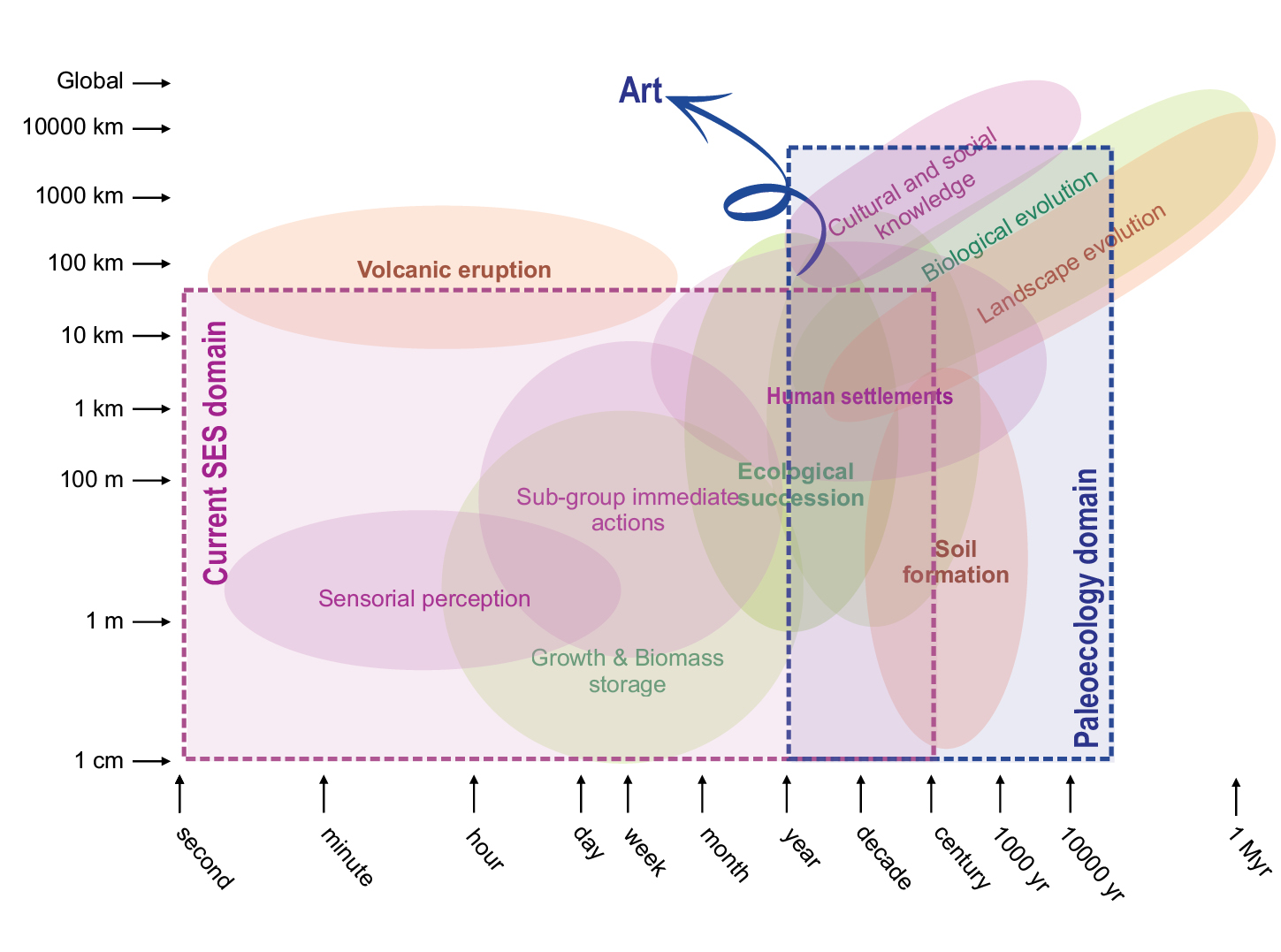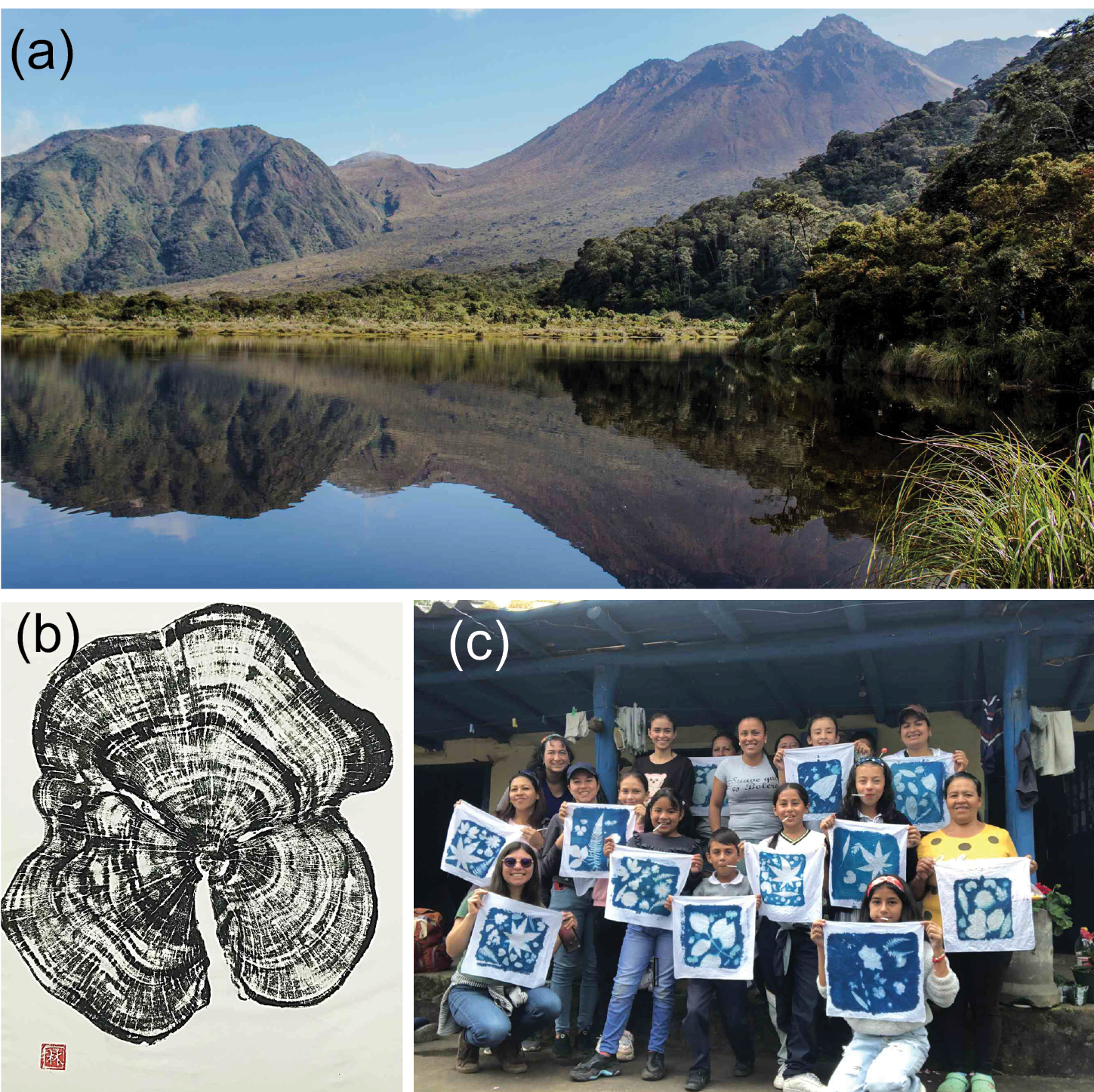- Home
- Publications
- PAGES Magazine
- Connecting Paleoecology and Art: A Novel Approach To Recall Socio–ecological Memories In Inhabited Volcanic Settings
Connecting paleoecology and art: A novel approach to recall socio–ecological memories in inhabited volcanic settings
Catalina González-Arango
Past Global Changes Magazine
31(1)
6-7
2023
Artistic approaches exploring concepts such as disturbance, resilience, and memory might help to connect paleoecology and traditional knowledge in active volcanic socio–ecological systems.
Inhabited volcanic territories are socio–ecological systems (SES) comprising not only the physical environment (i.e. geological, biological, climatic), but also social agents (e.g. ideologies, governance systems, beliefs). Thus, volcanic SES emerge from the interdependences between nature and culture, and constitute the perfect setting for addressing questions related to resilience and adaptation to natural hazards (Pardo et al. 2021).
Socio–ecological systems across timescales
Geologic, ecologic, and human processes occur at different temporal and spatial scales. Therefore, understanding their interactions is crucial for providing a firm underpinning for the interpretation of volcanic SES. For example, volcanoes can exist for millions of years, but eruptions can occur in the order of hours–years. Similarly, ecosystems at volcanic settings might be simultaneously modulated by forces that operate at very different timescales (e.g. orbital forcing or a pyroclastic flow). Human systems are not the exception, and current SES are built by many generations of people who have coexisted with natural phenomena in many different and dynamic ways (Fig. 1).
In this context, the interaction between processes and scales must be considered when reconstructing the long-term history of SES, and connect it with present generations. Therefore, an integration of methodological frameworks, wherein humans are components of processes operating at multiple spatial and temporal scales, is necessary.
Paleoecological multi-proxy techniques are tailored to face such complexity. Reconstructing the history of volcanic ecosystems through time, by simultaneously comparing vegetation (e.g. pollen), geological (e.g. geochemistry), and human-related proxies (e.g. charcoal from human-ignited fires, archaeological remains), offers the unparalleled possibility to reconstruct multiple lines of evidence throughout millennia. Such reconstructions serve as scenarios for testing hypotheses on causality, interconnectedness, and coexistence between natural and anthropogenic factors.
However, connecting the results from paleoecological reconstructions to modern societies is challenging, and they are rarely informative and meaningful enough to intervene in present configurations of SES. Here is where art becomes a powerful tool to fill the gap between past and present settings.
In volcanic settings such as the Doña Juana volcano in southwestern Colombia, the last volcanic eruption occurred almost a century ago (Pardo et al. 2023). However, people inhabiting such territories today struggle with the idea that their home is still an active volcano. The consequences of past eruptions on ecosystems and human societies have been buried and eroded by time. This poses the challenge of learning how past societies coexisted with this type of natural hazard.
Art has the power to evoke meaningful and emotional reactions in people, connecting personal memories to pasts generation. It may also connect with non-material aspects of such relationships (e.g. religious beliefs), which are completely out of the scope of paleoecology. Art, thus, acts as a bridge between our scientific-based findings and modern societies in many ways. Art helps to recall and reconstruct hidden and lost memories, which in this case involve plants, climate, and the volcano as evolving entities. Art might be used as an ethnographic tool to collect and share information about current and past human practices and knowledge, which might become crucial when interpreting paleoecological diagrams.
Here, two specific examples where art compliments paleoecology are presented. They not only help to communicate scientific concepts, but also provide new avenues to co-construct knowledge between local tradition and science. These experiences derive from the ongoing study of inhabited active tropical volcanoes (Pardo et al. 2021; Fig. 2).
The first example is inspired by the effect of fire in volcanic settings, which is preserved and gets manifested as individual burned trees. By using fire in the lab/studio, we can mimic the charring process that occurs naturally during eruptions and learn about wood preservation and the specific environment around the tree. The second example is the use of cyanotypes as an artistic technique that we have used with local communities to explore intergenerational memories about plants inhabiting the ecosystem near the volcano.
Recalling the memory of single trees through fire
Reconstructing past fires has become one of the main areas of interest when tackling past human–nature interactions. Fire in paleoecology is traceable by performing charcoal analysis in sediments, and more recently, with the help of more sophisticated techniques, paleoecologists have been able to distinguish between different fire regimes, combustion types, and fuel sources (e.g. Vachula et al. 2021). Ancient human practices related to, for example, cooking, hunting, or certain agricultural systems, can thus be traced back and differentiated from one another. But natural wildfires are also particularly common in volcanic settings, and are responsible for triggering deep and instantaneous changes in SES. In volcanic settings local fires are often caused by lightning, which is common during eruptions, but most of all, due to the high temperatures of pyroclastic and lava flows burning vast extensions of land and human infrastructures in their paths. In some cases, charred remains can be instantly buried by ash or lahars, favoring their exceptional preservation, and turning them into time capsules for next generations.
In volcanic landscapes, particularly where explosive eruptions occurred, it is common to find partially or fully burned timber embedded within large deposits of tephra (e.g. Hudspith et al. 2010). Such botanical remains are exceptionally well preserved and suitable as paleoenvironmental archives due to the water-repellent properties of charcoal, and the rapid burial by ash (Scott and Jones 1991).
Shou Sugi Ban, a Japanese art technique from the 18th century, uses this same principle to weatherproof and preserve wood for decades. In this sense, fire not only works as an agent of destruction, but it is also a medium to preserve legacies. By exploring this dual nature of fire, it is possible to use the remains of charred wood for artistic purposes to communicate ecological and geological concepts related to the history of ancient trees (e.g. age and identity of the tree, discrete vs. continuous processes), which can be difficult to explain to local communities living in volcanic SES. One example of this application is shown in Figure 2b, in which stamp inks are made from charred trunks to communicate about past ecosystems in volcanic SES. These prints are made in such a manner that the same fossil wood serves scientific purposes and artistic exploration.
Recalling collective memories through cyanotypes
When trained paleoecologists observe fossil pollen grains under a microscope, it is inevitable for them to make assumptions about past ecological settings in order to come up with an informed reconstruction of specific ecosystems in the past.
But what do those reconstructions mean to the communities which have lived on these sites for generations? Are those paleoenvironmental reconstructions meaningful in a broader context? How can we connect local knowledge to the scientific findings of past ecosystems to better interpret our paleoecological diagrams? Art, once again, might become a powerful tool to connect traditional knowledge of living communities in volcanic SES with scientific paleoecological understanding.
The last eruptive phase of the Doña Juana volcano occurred between 1897–1936 CE, four to six human generations ago. This means that a great deal of the collective memories of the event, and the overall knowledge of the society–volcano interactions, have been partially lost. Despite oral tradition, music, and other cultural expressions about the eruption, the youngest generations are particularly disengaged from the concept of the Doña Juana being a potential natural hazard.
To try to close this intergenerational gap, an art workshop was held in Las Mesas, a small town near the Doña Juana volcano, for children and adult women. They discussed the names, uses, and shapes of plants growing in their territory. We produced cyanotypes using local plants as stencils on fabric, which were then embellished with embroidery. Cyanotype is an ancient photographic technique that uses light and a photosensitive solution to print the shape of objects (e.g. plants), and was extensively used as a technique to document botanical collections in the 19th century.
The workshop allowed all the participants to recall the diverse relationships that people have with plants in their region. Using ancient scientific techniques with an artistic perspective enriched the experience. It facilitated an authentic integration of the participants, closed gaps between scientific and non-scientific knowledge and emotional and rational thinking, and created the encounter between past and present.
Acknowledgements
The author thanks Kawsay Cultural Center, all the inhabitants of Las Mesas, Nariño, Colombia, and the EHMS Research Group supported by Universidad de los Andes.
affiliation
Departamento de Ciencias Biológicas, Universidad de los Andes, Bogotá D.C., Colombia
contact
C. González-Arango: c.gonzalez2579 uniandes.edu.co (c[dot]gonzalez2579[at]uniandes[dot]edu[dot]co)
uniandes.edu.co (c[dot]gonzalez2579[at]uniandes[dot]edu[dot]co)
references
Hudspith VA et al. (2010) Palaeogeogr Palaeoclimatol Palaeoecol 291: 40-51
Pardo N et al. (2021) Nat Hazards 107: 1845-1880
Pardo N et al. (2023) Geol Soc Am Bull: b36557

